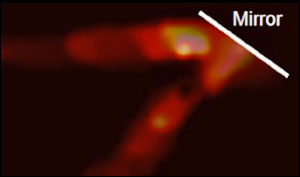Shooting at the speed of light
 For most of us, high-speed image capture, say 120 or 240 frames per second, is enough to get a good look at stuff happening in the blink of an eye -- like a water droplet hitting the ground or a Bichon Frisé snagging his favorite ball. For faster subjects, industrial-strength high-speed cameras can grab tens of thousands of frames per second (or more). But when your rapidly moving target is light itself, you're going to need something a bit quicker -- to the tune of 100 billion fps, according to Nature.
For most of us, high-speed image capture, say 120 or 240 frames per second, is enough to get a good look at stuff happening in the blink of an eye -- like a water droplet hitting the ground or a Bichon Frisé snagging his favorite ball. For faster subjects, industrial-strength high-speed cameras can grab tens of thousands of frames per second (or more). But when your rapidly moving target is light itself, you're going to need something a bit quicker -- to the tune of 100 billion fps, according to Nature.
Using a technique called "compressed ultrafast photography" (CUP), researchers at Washington University in St. Louis can track light as it travels and interacts with objects. It's a new spin on the streak camera method, where a sensor moves along with the light to record its motion. Previous streak camera setups have been limited to narrow, one-dimensional views, but the CUP technique allows for two-dimensional image capture. One example video shows a laser pulse sauntering by and reflecting off a mirror in a few tens of picoseconds (trillionths of a second).
Further reading at engadget.com
Image credit: Nature




